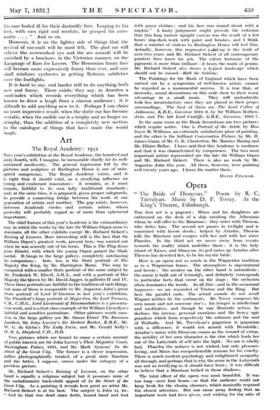Art
The Royal Academy: 1932
Tins year's exhibition at the Royal Academy, the hundred and sixty-fourth, will,. I imagine, be memorable chiefly for its well- sustained mediocrity. The general impression left by the pictures and sculpture at Burlington House is one of unin- spired competence. The Royal Academy exists, and it is right that it should exist, as a. steadying influence on young and exuberant innovators ; it remains, as it must remain, faithful to its own lofty traditional standards ; and, at the same time, it is prepared, given proper safeguards, to provide a connecting bridge between the work of one generation of artists and another. The gap exists, however, between Academic circles and certain artists whom posterity will probably regard as of more than ephemeral importance.
The chief feature of this year's Academy is the extraordinary way in which the works by the late Sir William Orpen seem to dominate all the other exhibits except Mr. Richard Siekert's Raising of Lazarus. More interesting still is the fact that Sir William Orpen's greatest work, present here, was carried out when he was scarcely out of his teens. This is The Play Scene from Hamlet, with which the young Orpen gained the Shute medal. It hangs in the large gallery, completely outclassing its companions ; here, too, is the State portrait of His Majesty the King, by Mr. Barrington Mann. This may be compared with a smaller State portrait of the same. subject by Mr. Frederick W. Elwell, A.R.A., and with a portrait of Her Majesty, the Queen by Mr. David Jagger, in galleries H and IV. 'these three portraits are faithful to the tradition of such things. but none of them is comparable to Mr. Augustus John's great State portrait of Lord D'Abernon in last year's exhibition. 'the President's large portrait of Major-Gen. the Lord Treorcen, C.M.G., Lord Lieutenant of Monmouthshire is a presenta- tion work, and is a first-class example ofSir William Llewellyn's faithful and sensitive portraiture. Other pictures worth men- tion in the large gallery are Mr. Simon Elwes' The Baroness Lambert,, Sir John Lavery's Sir Herbert Barker, K.B.E., Mr. W. G. de Glehn's The Lady Irwin, and Mr. Gerald Kelly's II. R. L. Shepherd, C.II., Two pictures which are bound to cause a certain amount of public interest are Sir Jolm Lavery's Their Majesties' Court, Buckingham Palace, 1931, and Mr. Mark Symons' In the Street of the Great City. The former is a clever impression, rather photographically treated, of a great state function and the latter, I suppose, comes under the category of a problem picture.
Mr. Richard Sickert's Raising of Lazarus, on the other band is equally a religious subject but it possesses none of the melodramatic-back-cloth appeal of In the Street of the Great City. As a. painting it reveals how great an artist Mr. Richard, Sickert is at his best. The subject is John xi 44 ; " And he that was dead came forth, bound hand and foot with grave clothes : and his face was pound about with a napkin." A hasty judgement might provide the criticism that this long narrow upright canvas was the result of a few hours slap-dash work with paint and brushes, and I think that a number of visitors to Burlington House will feel this. Actually, however, this impressive plaiting is the work of over two years, and Mr. Richard Sickert of all contemporary painters does know his job. The colour harmony of the pigments is more than brilliant—it bears the mark of genius. Mr. Richard Siekcrt also shows a typical landscape which should not be missed—Bath the Sublime.
The Paintings for the Bank of England which have been carried out by a symposium of well-known artists cannot be regarded as a monumental success. It is true that, of necessity, mural decorations on this scale show to their worst advantage in a small room. They will undoubtedly look less unsatisfactory once they are placed in their proper surroundings. The best of them are The Lord Cullen of Ashbourne, K.B.E., Governor 1918-9, by Sir William Rothem stein, and The late Lord Cunliffe, G.B.E., Governor, 1918-7.
In the same room as the Bank decorations are two pictures which require notice. One is Portrait of the Artist, by Miss Joyce M. Williams, an extremely satisfactory piece of painting, and the other is the brilliant Conversation Picture, by Mr. 11. James Gunn, of Mr. G. K. Chesterton, Mr. Maurice Baring and Mr. Hilaire Belloc. I have said that this Academy is mediocre and that it was characterized by competence. The two most important artists represented are the late Sir William Orpen and Mr. Richard Sickert. There is also no work by Mr. Augustus John this year. All these, however, were painting well twenty years ago. I leave the matter there.
Davin FINCHAPC






































 Previous page
Previous page